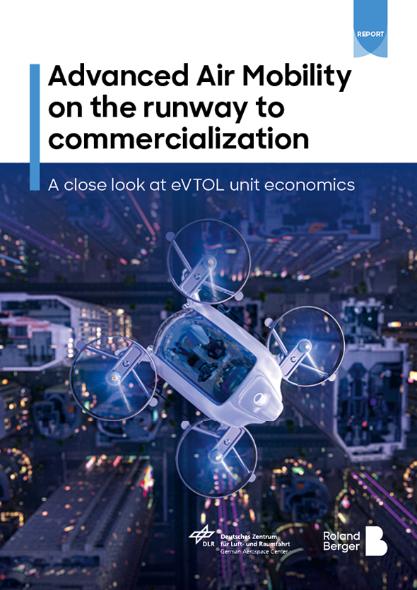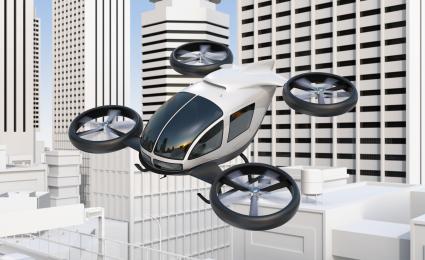Find out which requirements there are to receive a commercial certification and why these certifications are relevant to Advanced Air Mobility.


Advanced Air Mobility
By Manfred Hader and Stephan Baur
Navigating the hype cycle: a close look at the unit economics of Advanced Air Mobility
Investment in the nascent Advanced Air Mobility (AAM) has stalled. After a dramatic surge in 2021, investments in 2022 and 2023 fell sharply. Macroeconomic pressures are a major factor, while investors have also realized that the market will take longer than expected to develop. So, just how economically viable is the AAM market? In a new joint study, Roland Berger and the German Aerospace Center (DLR) analyze the unit economics of electrical Vertical Take-Off and Landing (eVTOL) aircraft covering three different passenger use cases. Despite finding that unit economics are higher than OEMs have claimed, we believe there is a future for the market – albeit with adjustments required.

"The efficient alignment of each building block in the AAM ecosystem is an important driver of unit economics."
Before Advanced Air Mobility can truly take off, aircraft OEMs and potential AAM operators must achieve both a technical and commercial proof-of-concept. The former requires regulators and OEMs to collaborate on the necessary framework and validation methods to certify aircraft and organizations to the highest safety standards. To establish commercial proof of concept, operators and OEMs must work with a range of industry stakeholders and set up a comprehensive supporting ecosystem, from vertiports to new air traffic management systems. Only the efficient alignment of all relevant ecosystem cost blocks will enable AAM’s economic viability and drive unit economics.
Yet many components within this ecosystem are currently undeveloped, posing major uncertainties in building a reliable business case. To help prospective operators, we carried out an economic analysis of the viability of using eVTOL aircraft for passenger air taxi services.
"Operational costs are influenced by the entire ecosystem, not just the Advanced Air Mobility aircraft. Therefore, eVTOL OEMs and operators should collaborate with all stakeholders to provide the most efficient and effective AAM service."
Cost analysis for three air taxi use cases
With commercial flights yet to begin, most economic data on AAM comes directly from OEMs. To shed more light on the unit economics, as well as operational requirements and challenges facing OEMs, we looked at three potential use cases in and around the German city of Hamburg: City Taxi, across a distance of around 20 km; Airport Shuttle, traveling approximately 25 km; and an Inter-City route of around 225 km to the island of Sylt in the North Sea.
We divided our results into two core focuses: firstly, distribution of direct operating costs, covering the costs of flying, vertiports, maintenance, and the aircraft itself; secondly, absolute ticket price, which considered indirect operating costs and operator margins as well as the load factor.
For each use case, our study highlights the direct cost blocks operators can address to improve unit economics. These range from considering low-cost vertiports to switching to remotely piloted or autonomous flights or improving battery cycle time.
When looking at ticket prices for each route, we considered variables such as the development of battery costs and battery lifetimes as well as potential vertiport landing fees.
AAM: Fast, but too expensive?
What did we find? For each route, the air taxi is always the fastest option when comparing with ground transport options, but it is also an expensive one. In the City Taxi use case carrying one passenger and one pilot, the per-passenger mile price was more expensive than existing helicopter services, although this would change significantly if a remote pilot or autonomous aircraft would be used, freeing up space for an additional passenger.
The Airport Shuttle use case carrying three passengers and one pilot resulted in slightly higher unit economics than OEMs have claimed, although the difference doesn’t stretch to orders of magnitude. The price would be lower than existing helicopter services and the time saving compared to ground transport options would justify the price premium for air taxi services – especially for less price sensitive business travellers.
For our Inter City use case, AAM is considerably faster than ground-based alternatives, but significantly more expensive than using a car or public transport. Our calculated ticket price is similar to that of an existing airline shuttle already running between the two locations. In addition, the results indicate attractive unit economics for the emerging Regional Air Mobility (RAM) segment, focusing on electric Short Take-Off and Landing (eSTOL) fixed-wing commuter aircraft.
How eVTOLs can capture a wider market
Based on these results, we believe eVTOL AAM use cases will remain limited to a niche premium market in its early years. For eVTOLs to achieve long-term success and capture a wider market, OEMs, operators, and other sector stakeholders must collaborate to enhance each building block within the ecosystem, reducing unit economics for air taxi services.
The study has been co-authored by Sven Kopera.
Register now to access the full study, to gain deeper understanding of eVTOL aircraft economics in the AAM market.


_image_caption_none.png?v=1083137)

_image_caption_none.png?v=1083139)
_image_caption_none.png?v=1083140)



